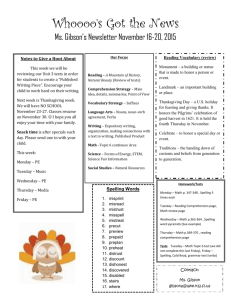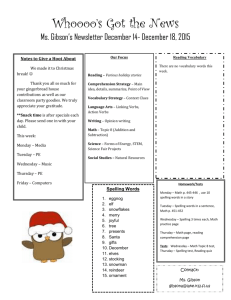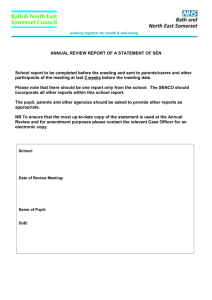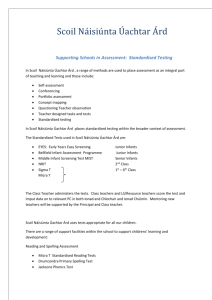Guidelines for Literacy Tests Post Primary
advertisement
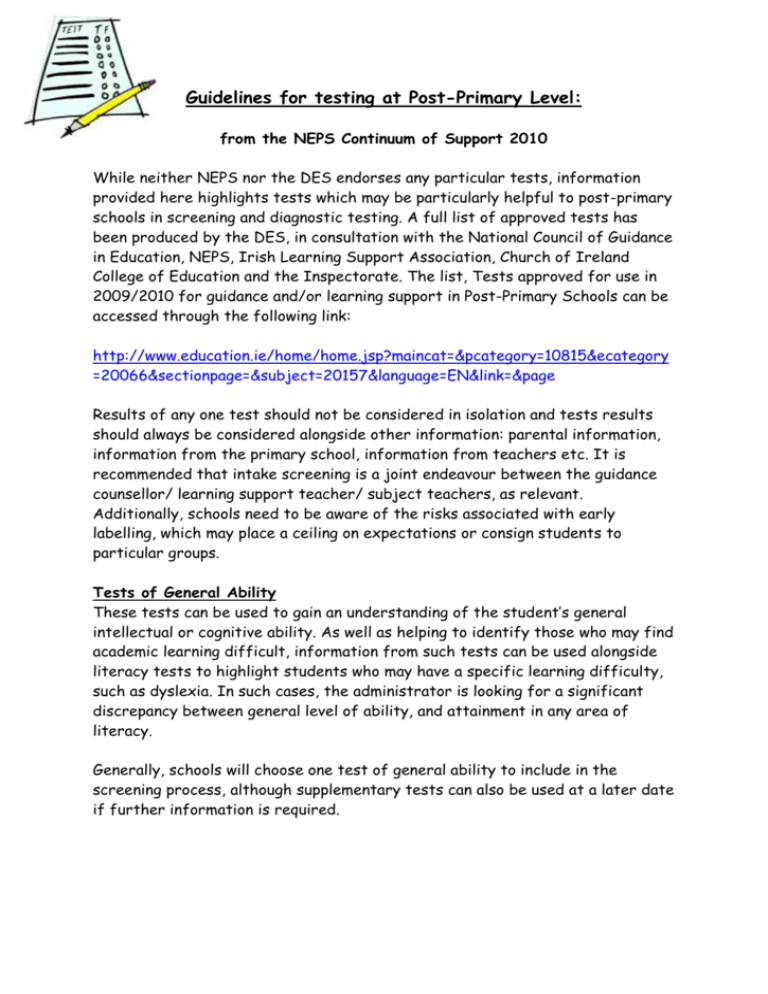
Guidelines for testing at Post-Primary Level: from the NEPS Continuum of Support 2010 While neither NEPS nor the DES endorses any particular tests, information provided here highlights tests which may be particularly helpful to post-primary schools in screening and diagnostic testing. A full list of approved tests has been produced by the DES, in consultation with the National Council of Guidance in Education, NEPS, Irish Learning Support Association, Church of Ireland College of Education and the Inspectorate. The list, Tests approved for use in 2009/2010 for guidance and/or learning support in Post-Primary Schools can be accessed through the following link: http://www.education.ie/home/home.jsp?maincat=&pcategory=10815&ecategory =20066&sectionpage=&subject=20157&language=EN&link=&page Results of any one test should not be considered in isolation and tests results should always be considered alongside other information: parental information, information from the primary school, information from teachers etc. It is recommended that intake screening is a joint endeavour between the guidance counsellor/ learning support teacher/ subject teachers, as relevant. Additionally, schools need to be aware of the risks associated with early labelling, which may place a ceiling on expectations or consign students to particular groups. Tests of General Ability These tests can be used to gain an understanding of the student’s general intellectual or cognitive ability. As well as helping to identify those who may find academic learning difficult, information from such tests can be used alongside literacy tests to highlight students who may have a specific learning difficulty, such as dyslexia. In such cases, the administrator is looking for a significant discrepancy between general level of ability, and attainment in any area of literacy. Generally, schools will choose one test of general ability to include in the screening process, although supplementary tests can also be used at a later date if further information is required. Non Reading Intelligence Test, Level 3, 1989, D Young, Hodder and Stoughton This group administered test focuses on verbal skills. Importantly, reading skills are not required (although some knowledge of the alphabet is needed). This test takes about 45 minutes to administer and is suitable for use by qualified teachers. Level 3 is standardised up to the age of 13 years, 11 months. At this age range, the NRIT will usefully identify children at risk of general learning difficulties, but it is does not give standardised information about those in the upper part of the average range, or about children whose ability may be above average. Research by NEPS psychologists suggests that the NRIT results correlate reasonably well with the results of the WISC IV. Drumcondra Reasoning Test, 1998, Education Research Centre The Drumcondra Reasoning Test (DRT) is an objective, group-administered test of cognitive skills which can be used to assess students in transition between primary and post-primary schooling, or in the early years of post-primary schooling. There are two parallel forms of the DRT (Form A and Form B). Each form contains two subtests, Verbal Reasoning and Numerical Ability. The test takes approximately 1½ hours to administer. Students mark their answers on a hand-scorable answer sheet, (which can be scored using a scoring stencil), or on a machine-scorable answer sheet, (which can be returned to the Educational Research Centre to be scored by machine). Use of the DRT is restricted to qualified persons with training in the administration and interpretation of psychological tests (e.g., guidance counsellors, psychologists). This test has the advantage of having been normed on Irish students. Cognitive Abilities Test, third edition (CAT 3) 2003, gl-assessment This test is group administered and explores three areas of ability: verbal, quantitative and non-verbal. It is suitable for students in the age range 7 years 6 months to 17 years. Irish norms for the CAT 3, Level E (11.06-14.00+) and Level F (13.06-15.00+) are available to download free from Educational Evaluation (www.edev.ie) Level E is appropriate for first year students in postprimary schools. The CAT 3 can be used by teachers, but they must be registered users. The Irish CAT 3 Level E is only available from Educational Evaluation, see www.edev.ie Tests of Literacy Skills- Reading There are many ways of testing reading, including word reading, sentence completion and close exercises. Word reading tests, by their nature, are individually administered, while group tests, used at screening, usually depend on some element of comprehension. Teachers should be aware that some students can perform well on a reading comprehension task, but still have significant difficulty with reading accuracy and fluency. MICRA-T (2004) Mary Immaculate College Reading Attainment Test Level 4 of this test is intended for use with fifth and sixth class students of primary age and therefore may be suitable for summer in-take screening. The test is group administered and Irish normed. Drumcondra Primary Reading Test- revised 2007 This group administered test takes about one hour and 35 minutes. It tests both reading vocabulary and reading comprehension and Level 6 of the test is suitable for end of sixth class (and therefore for intake screening). The test has Irish norms Please note, if the school chooses to use a test that is standardised for use with 6th class students, it may be helpful to check the practice in primary schools, so there is no unnecessary duplication or practice effect risks. Group Reading Test, GRT II, gl-assessment (2005) The sentence completion forms (C & D) and context comprehension forms (X & Y) are standardised (using British norms) for students aged 9 years to 15 years, 3 months. This is a group administered tests and takes about 30 minutes. Tests of Literacy Skills- Spelling A test of spelling skills can be very helpful in identifying those who may be at risk of dyslexia. Teachers should pay special attention to those students who appear to be significantly underperforming relative to their general level of ability. Many schools found the Single Word Spelling Test, (SWST 2003) nfer-nelson (standardised up to age 14) useful but this is going out of print. The British Spelling Test Series, (1996), gl-assessment, level 3 is a suitable alternative. It is standardised from ages 9 to 15 years, 11 months and can be group or individually administered. It takes 30-40 minutes and uses UK norms. The Graded Word Spelling Test (2006) is also suitable. It is a revision of the Vernon tests. It is standardised for the ages 5 to 18+ and can be administered individually or to groups, in 20-30 minutes. It uses UK norms. Other tests of literacy Informal Dictation It may also be helpful to ask students to complete a short piece of dictation. Such a test can yield useful information about a range of skills, including: rate of writing, handwriting legibility, listening skills and spelling skills. While standardised results are not available, an experienced teacher should be able to identify students who have weaker skills in key areas. These students may need further diagnostic testing. There is also the Detailed Assessment of Speed of Handwriting Test (DASH 2007, Harcourt Assessment) which can be group administered and is standardised from ages 9 to 16 years, 11 months. It takes 30 minutes and involves five short subtests, including a 10 minute free writing activity. See www.pearsonpsychcorp.co.uk Guidance on the use of Diagnostic and Individual Tests and Tests for Older Students Tests of Ability/ Aptitude for Older Students The CAT 3 (see above) is standardised up to the age of 17 and therefore can still be useful, with older students. Additionally, some schools find the Differential Aptitude Tests for Schools (DATS 1997), to be useful in identifying aptitudes towards the end of the junior cycle. It can also be used with older students and has Irish norms. DATS has 8 subtests, verbal reasoning, abstract reasoning, perceptual speed and accuracy, mechanical reasoning, space relations, spelling and language usage. This test is for use by guidance counsellors. Tests of Ability for Students who Do Not Have English as a First Language Testing students with different linguistic and cultural backgrounds (including Traveller children) is problematic. These tests can be used by special needs teachers. However, the Naglieri (see below) test is relatively expensive and may be best as a shared resource between a number of schools, perhaps available through the local Education Centre. The Ravens Progressive Matrices- Revised 2008 may be useful. This is considered a language-free and culturally-fair test. It is suitable for group and individual administration and covers the full age range (5 years to 80 years). The Naglieri Non-Verbal Test (1996) is also a language free, culturally fair, group administered test, with British norms, covering the age range 5 to 17 years. A more up-to-date version (2003) is available for individual administration. Test of Literacy for Older Students The Adult Reading Test (2004) is suitable for the age range 16 – 55 years. It is a test that needs to be individually administered. It has UK norms and is published by the Psychological Corporation. The Wide Range Achievement Tests (WRAT 4 2006) includes word reading, reading comprehension and spelling tests. It is suitable for the complete age range and uses US norms. This individually administered test also includes a maths assessment. This test may be particularly helpful in considering RACE applications. Diagnostic Reading Tests The Neale Analysis of Reading Ability (NARA II 1997) has been widely used, but is of limited utility in Post-Primary schools as it is only standardised up to the age of 12 years, 11 months. It offers a comprehensive assessment of reading rate, accuracy and comprehension. This test uses British norms. A more up-to-date alternative, which covers a wider age range is the Diagnostic Reading Analysis (2006) published by Hodder. This covers the age range 7 to 16 years and is particularly suitable for testing less able students. It is individually administered and covers reading accuracy, comprehension, fluency and rate of reading. Finally, there is also Wechsler Individual Achievement Test for use by teachers. This WIAT for Teachers II (2006) can be used across the age range and has both US and UK norms. It is an individual assessment which covers the following areas: word reading, reading comprehension, reading rate and spelling.

